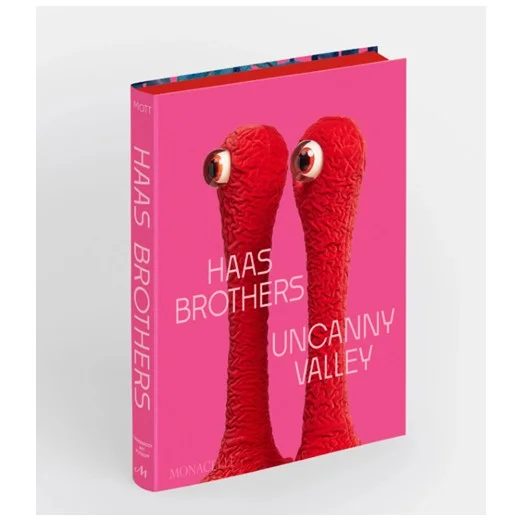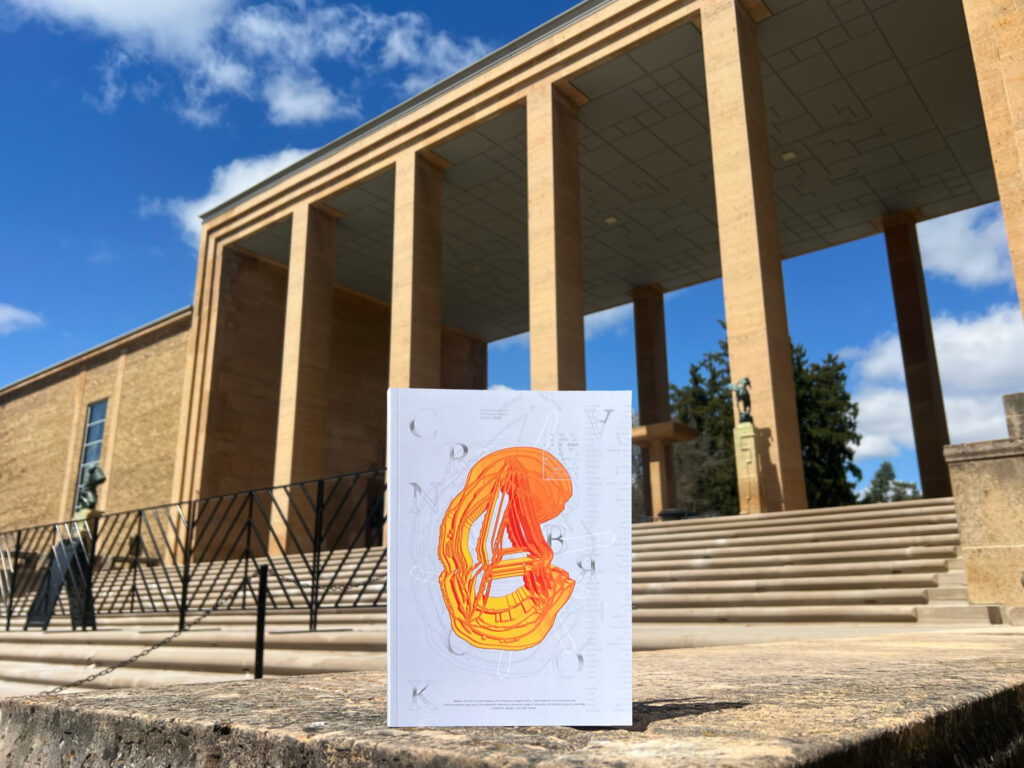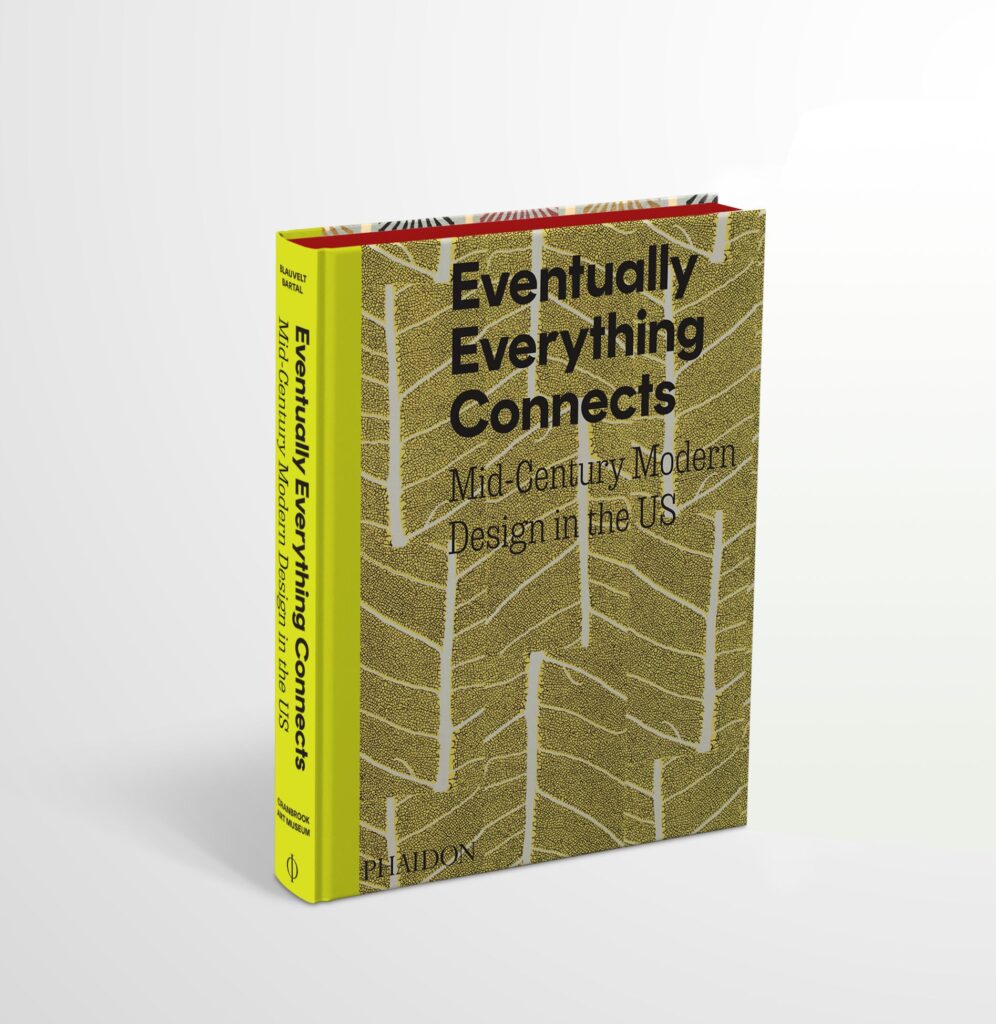Based in metro Detroit, Akea Brionne (b. 1996) is an interdisciplinary research-driven artist working at the intersection of lens and fiber-based media. Her practice explores the relationship between colonial and imperialist histories and their reverberations into cultural storytelling, identity politics, and assimilation. Through observations focusing on the African Diaspora with a particular interest in Afro-Creole culture, Brionne utilizes emerging technologies like artificial intelligence and digital weaving to translate surreal compositions into multidimensional tapestries adorned with glitter, sequins, and rhinestones.
Situated in Cranbrook Art Museum’s North Gallery, Brionne will display recent and new bodies of work engaging with installation and sculptural elements in conversation with the museum’s built architectural environment, experimental craft, and mid-century design legacy. Foregrounding Brionne’s background in photography, Fresh Paint: Akea Brionne invites visitors to consider intersecting narratives of agency, subjecthood, and interiority.
Brionne is a 2023 graduate of the Photography Department at Cranbrook Academy of Art, and Fresh Paint: Akea Brionne is the artist’s first solo museum exhibition and the fourth installment of Cranbrook Art Museum’s Fresh Paint series, which highlights recent work from Detroit-area contemporary artists.
Fresh Paint: Akea Brionne is organized by Cranbrook Art Museum and curated by Katy Kim, the Jeanne and Ralph Graham Curatorial Fellow, with support by Laura Mott, Chief Curator. This exhibition is generously supported by the Gilbert Family Foundation, Fred and Barbara Erb Family Foundation, and the Deroy Testamentary Foundation.Labyrinth/Laboratory: Selections from the Cranbrook Collection presents work by alumni and faculty of Cranbrook Academy of Art, drawn from Cranbrook Art Museum’s permanent collection of over 8,000 objects. Largely focused on work produced since the 1960s, Labyrinth/Laboratory: Selections from the Cranbrook Collection places into dialogue various aesthetic, material, and conceptual connections across time by Academy artists.
Opening in 1932, Cranbrook Academy of Art evolved from a series of artisanal craft workshops to become one of the most experimental art schools in the United States. Unlike the Bauhaus (1919–1933), the “art school of modernism,” or Black Mountain College (1933–1957), the art school of the postwar avant-garde, Cranbrook lacked a singular artistic manifesto. Instead, three spatial metaphors would come to define the Academy: the creative community of the artist colony; the atelier or workshop model; and the design laboratory. Combined with an absence of required classes, coursework, and grades, the confluence of these factors forged a radical pedagogy of learning through doing.
Highlighting recent acquisitions to the permanent collection, the design for this exhibition adopts the essential interlocking motif of Eliel Saarinen, the founding president of the Academy and the master architect of its historic campus, as a metaphor for one’s education at the Academy: a labyrinth of one’s own making and a laboratory perpetually fueled by experimentation.
Labyrinth/Laboratory: Selections from the Contemporary Cranbrook Collection is organized by Cranbrook Art Museum and curated by Kat Goffnett, Associate Curator of Collections, and Katy Kim, the Jeanne and Ralph Graham Curatorial Fellow. The exhibition is supported, in part, by the Gilbert Family Foundation, the George Francoeur Art Museum Exhibition Fund, the Clannad Foundation, and ArtMembers at Cranbrook.The innovative work from the next generation of architects, artists, and designers will be on display at the 2026 Graduate Degree Exhibition of Cranbrook Academy of Art. The Degree Exhibition showcases pieces that are the culmination of two years of studio work from a diverse group of graduates as they launch their careers.
An ArtMembers Opening Preview Party will be held on Saturday, April 11, 2026, from 6 to 9pm. Registration will be available closer to the event.
Pop art emerged in Britain and the United States in the late 1950s, becoming a worldwide phenomenon through the 1960s and 1970s. Taking popular culture as a source of inspiration, Pop art often employs bold colors; commercial design, and printing techniques; everyday, sometimes banal, subject matter, or conversely, images from celebrity life and mass media. Pop art had mass appeal, influencing not only artists and designers but also the mass culture itself.
Pop Art Pop-Up features works drawn from Cranbrook Art Museum’s permanent collection, showcasing the work of iconic Pop artists such as Jim Dine, Roy Lichtenstein, Robert Rauschenberg, Jasper Johns, Andy Warhol, Claes Oldenburg, and more. The exhibition also underscores the enduring influence of Pop in the work of later artists and designers like Ed Rossbach, Terence Main, and Keith Haring, and in the work of contemporary artists such as KAWS.
Works on view in Pop Art Pop-Up pair with this season’s Wainger Workshops, artist-led sessions exploring collage, printmaking, and instant photography on select winter Thursdays.
Pop Art Pop-Up is curated by Cranbrook Art Museum Director Andrew Satake Blauvelt with the assistance of Kat Goffnett, Associate Curator of Collections, and Katy Kim, the Jeanne and Ralph Graham Curatorial Fellow. Pop Art Pop-Up is indebted to the significant gifts from Dr. John and Rose Shuey, the Andy Warhol Foundation for the Visual Arts, the Estate of George Francoeur and Gerald Earls, and Kari and Nicholas Coburn, among others.
Cranbrook Art Museum is generously supported by the Fred A. and Barbara M. Erb Foundation, the Kresge Foundation, the MASCO Foundation, the DeRoy Testamentary Foundation, the Governors of Cranbrook Academy of Art and Cranbrook Art Museum, members of the Museum Committee, and ArtMembers at Cranbrook.
This project is supported by the Robert Rauschenberg Foundation.
In 1974, Cary Loren, Mike Kelley, Jim Shaw, and Niagara joined forces to form Destroy All Monsters (DAM), an anti-rock band and artist collective. Named after a Japanese monster movie, the group was formed as an outlet for the young creatives in Ann Arbor, Michigan, to explore their rebellious interests in pop culture, film, art, and music at a time when, according to Loren, “a sense of gloom, disaster, and apocalypse, mixed with doses of anarchy, comedy, and absurdity kept us together.”
Over the past half-century, Destroy All Monsters has lived through an array of evolutions spurred on by line-up changes, creative differences, and changes of focus as the core four members have oscillated between this project and solo practices. DAM projects have included noise and rock music, Xerox art, avant-garde films, cutting-edge zines, and exhibitions in the United States, Europe, and Japan.
Mythic Chaos: 50 Years of Destroy All Monsters traces the group’s lineage from the early 1970s through today, featuring key moments in the collective’s creative arc. This exhibition explores the group’s source inspirations, including formative moments at God’s Oasis, their early practice space, and the title of their first Xerox fliers. In addition, Mythic Chaos will feature iconic posters, zines, photographs, collages, films, drawings, and banners selected from the DAM archive from 1974 onward. A new iteration of the collective’s “blob” sculpture, The Crème Filled Palace, will be created at Cranbrook. Mythic Chaos aims to not only illustrate the trajectory of Destroy All Monsters but to look at its underpinnings and unveil the often fringe cultural mythos that brought the group together in the post-hippie, pre-punk era.
Mythic Chaos: 50 Years of Destroy All Monsters is organized by Cranbrook Art Museum and curated by Kat Goffnett, Associate Curator of Collections, and Lyla Catellier, Curator of Public Programming, and with the assistance of Cary Loren, Jim Shaw, Niagara, and the Mike Kelley Foundation for the Arts.Haas Brothers: Uncanny Valley is the first mid-career survey devoted to artists and twin brothers Nikolai and Simon Haas (b. 1984, Austin, Texas), who founded their collaborative studio in Los Angeles in 2010. The duo is known for their artistic practice that cross-pollinates the fields of art, craft, design, and technology.
The brothers’ materially rich work reveals a frenzied creative imagination combined with a right-brain inventiveness—a process they refer to as “problem-solving fantasies.” Much of their art is a continuation of fictive characters, fantastic creatures, and other-worldly realms often filtered through cultural references and technological aesthetics of growing up in the 1990s and early aughts. Often irreverent and always meticulous, their artworks explore themes related to nature, fantasy, the subconscious, and the human experience. Conceptually, they embrace the surrealistic, the animistic, and the zoomorphic, for instance, to conjure alternative realms.
The exhibition includes examples from the major bodies of work that the artists have been engaged with over the last 15 years presented through striking vignettes that bring to life the Haas Brothers’ “worlds.” It will also show how these works and worlds are made by highlighting their processes, material explorations, and innovations.
The Haas Brothers have exhibited their work widely throughout the United States and abroad. They have been the subject of solo exhibitions at the Nasher Sculpture Center; Katonah Museum of Art; Bass Museum of Art; Savannah College of Art and Design Museum of Art; and have been featured in numerous group exhibitions. In 2019, they were recipients of the YoungArts Foundation Arison Award. Their work is in the permanent collections of the Rhode Island School of Design Museum of Art; the Cooper Hewitt, Smithsonian Design Museum; and the Metropolitan Museum of Art.
The exhibition will be accompanied by a 256-page monograph, available from our shop, the most comprehensive treatment of the Haas Brothers’ career to date, with new curatorial insights and co-published by Cranbrook Art Museum and Monacelli Press with the assistance of the Nasher Sculpture Center.
The exhibition will tour to venues across the United States, including the Museum of Arts and Design (MAD), New York, April 11, 2026 – September 13, 2026. Other venues will be announced at a later date.

The innovative work from the next generation of architects, artists, and designers will be on display at the 2025 Graduate Degree Exhibition of Cranbrook Academy of Art. The Degree Exhibition showcases pieces that are the culmination of two years of studio work from a diverse group of graduates as they launch their careers.

Purchase the 2025 Graduate Degree Exhibition Book in person and online while supplies last. Designed by Mike Michalski (CAA 2D Design 2025) and Daniel Lee (CAA 2D Design 2025).
ArtMembers save 15% with code “ArtMem”.
Not an ArtMember? Join today!
This large-scale survey of one of the most important and persistent movements of modern design in the United States in the twentieth century shines a light on Cranbrook’s pivotal role in its development and the contributions of additional women, LGBTQ+ individuals, and designers of color during this period. Based on the famous quote by Cranbrook alumnus and teacher Charles Eames, “Eventually everything connects: people, ideas, objects,” the exhibition contains some 200 works by nearly 100 artists, architects, and designers that explore the multitude of relationships between these three fundamental pillars. The exhibition features many new additions to Cranbrook’s collection of important furniture, textiles, and furnishings from the period.
This expansive exhibition is accompanied by an equally expansive 400-plus-page book published with Phaidon and available from our shop (pre-order, shipping in July) that contains new insights by more than 25 historians.

Virtual Tour of Eventually Everything Connects: Mid-Century Modern Design in the U.S.
In 2016, Cranbrook Art Museum inaugurated a new permanent collection devoted to celebrating and preserving the work of artists and designers in the metro Detroit area—its first new collection in decades. At the same time, the Art Museum dedicated funds to acquire more works by women, artists of color, and LGBTQ+ identified individuals in a project to diversify its permanent collection. Designed to acknowledge the long-standing history of artists who have called Detroit home and the area’s rich and diverse community of practitioners, the Detroit Collection is particularly focused on art from the 1960s to the present in a variety of media. How We Make the Planet Move takes its title from a poem by Detroit-born poet, jessica Care moore, A Poem Saved My Life: An Homage to Detroit. Cranbrook Art Museum’s Detroit Collection itself aims to hold the art of Detroit up, giving it the attention and reverie it has rightfully earned. This landmark exhibition represents the first public debut of works from this collection, which has been amassed through generous gifts, museum purchases, and commissions.
How We Make the Planet Move is the inaugural exhibition in Cranbrook’s Detroit Collection series as the museum continues to grow to include more artists working in and around the city.
Virtual Tour of How We Make the Planet Move: The Detroit Collection Part I
The Detroit Collection is organized by Cranbrook Art Museum and curated by Kat Goffnett, Associate Curator of Collections, with Laura Mott, Chief Curator, and Andrew Satake Blauvelt, Director. The exhibition is generously supported by the Gilbert Family Foundation, the DeRoy Testamentary Foundation, Jennifer and Dan Gilbert, the Tom Gores Foundation, Kim and Mark Reuss, the George Francoeur Art Museum Exhibition Fund, National Endowment for the Arts, Michigan Arts and Culture Council, Media Genesis, Andrew L. and Gayle Shaw Camden, Marc Schwartz and Emily Camiener, and ArtMembers of Cranbrook Art Museum.
Toshiko Takaezu is one of the most accomplished artists to work with clay in the twentieth and twenty-first centuries, acclaimed for her vessels that she treated like canvases for expressive abstraction. Born in Hawai‘i to Okinawan immigrant parents, Takaezu came to study and eventually teach in the summer program at Cranbrook Academy of Art between 1951-1956. This major exhibition centered on her life and work is the first nationally touring retrospective of Takaezu’s work in twenty years.
Worlds Within is a chronological retrospective that charts the development of Takaezu’s hybrid practice over seven decades, documenting her early student work in Hawai‘i and at Cranbrook through her years teaching at the Cleveland Institute of Art and later at Princeton University. To represent this evolution, the show will present a series of installations loosely inspired by ones that Takaezu created in her own lifetime: from a set table of functional wares from the early 1950s to an immersive constellation of monumental ceramic forms from the late 1990s to early 2000s. The exhibition will include a vast collection of ceramic sculptures including her signature “closed forms,” Moons, Garden Seats, Trees, and select monumental works from her late masterpiece, the Star Series. It will also feature a broad selection of her vibrant and gestural acrylic paintings and weavings, many of which have rarely been seen. Sound will also play an important role in this exhibition as many of Takaezu’s closed ceramic forms contain unseen “rattles”.
To coincide with the exhibition, a new monograph was published in association with Yale University Press, for which Cranbrook Art Museum contributed new scholarship. This timely exhibition and publication arrive just as Takaezu’s work is receiving renewed critical attention as one of the great modern abstractionists.
Virtual Tour of Toshiko Takaezu: Worlds Within
Toshiko Takaezu: Worlds Within is organized by The Isamu Noguchi Foundation and Garden Museum, New York, with assistance from the Toshiko Takaezu Foundation and the Takaezu family, and curated by Glenn Adamson, Kate Wiener, and Leilehua Lanzilotti. The exhibition was conceived and developed with former Noguchi Museum Senior Curator Dakin Hart.
This exhibition would not have been possible without the leadership support of the Terra Foundation for American Art and the Henry Luce Foundation.
The Cranbrook Art Museum presentation is generously supported by the Gilbert Family Foundation, the George Francoeur Art Museum Exhibition Fund, and Karen and Drew Bacon.


Copyright © 2025 Cranbrook Art Museum. All rights reserved. Created by Media Genesis.